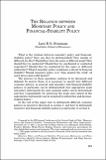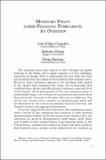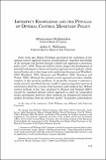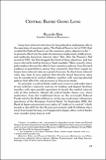Buscar
Mostrando ítems 1-10 de 533
The relation between monetary policy and financial-stability policy
What is the relation between monetary policy and financialstability policy? How can they be distinguished? How similar or different are they? Should they have the same or different goals? How should they be conducted? Should they be coordinated or conducted separately? Should they be conducted by the ...
Central banks and sustainability: a comprehensive review of green mandates, speeches, and actions
, there is also an emphasis on how monetary policy should integrate climate change and environmental considerations. This paper aims to examine the various ways central banks are addressing these issues....
The fiscal footprint of macroprudential policy
, and this creates seignorage revenues. Inflation unexpectedly rises and this lowers the real value of public debt. Rolling over this debt is cheaper as the price of newly issued debt rises. And finally, economic activity rises, so tax revenues increase and social...
Risks to central-bank independence
their power or remit. These include everything from enhanced financial regulation to quasi-fiscal policy to mitigating economic inequality. Some recent populist proposals appear to be based on the presumption that central banks can issue large quantities...
Monetary policy under financial turbulence: an overview
The financial crisis that started in 2007 brought the global economy to the brink and in many respects it is still unfolding especially in Europe. How to understand and deal with the crisis has naturally been the subject of fierce debates that continue today. However some consensus appears to be ...
Macro-prudential policy and the conduct of monetary policy
The 'Great Contraction' in global economic activity triggered by the financial crisis and the extraordinary fiscal and monetary measures that public authorities had to undertake in order to put the economy back on track by putting public finances under heavy strains and leading to extremely low ...
Imperfect knowledge and the pitfalls of optimal control monetary policy
Sixty years ago, Milton Friedman questioned the usefulness of the optimal control approach because of policymakers’ imperfect knowledge of the economy and favored instead a simple rule approach to monetary policy (1947, 1948). These are still live issues, despite the development of powerful techniques ...
Monetary policy under uncertainty and learning: an overview
Central bank economists and academic economists conducting research on the design of monetary policy have made significant advances in recent years. This work has led to a clearer understanding of the desirable properties of interest rate rules, the role of announcements and communication, and the ...
Central banks going long
Long-term interest rates have for long played an ambiguous role in the operation of monetary policy. The Federal Reserve Act of 1913 that created the Federal Reserve set the monetary policy objective to be: '... to promote effectively the goals of maximum employment stable prices and moderate long-term ...
Public trust and central banking
Central bank independence is one of the most remarkable pieces of institutional architecture fostered by economic thinking in the last half century. Theoretical studies in the 1980s stressed central bank independence as a precondition to bringing...







